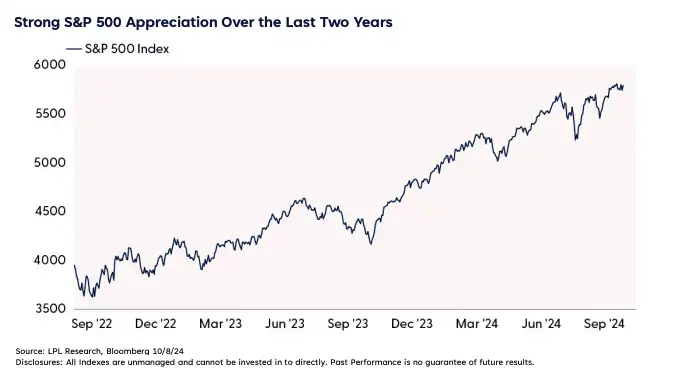3 signs investors should expect the bull market to continue for a third year in 2025

The stock market has been experiencing a bull market for the last two years.
The S&P 500 bottomed in October 2022 and has gained nearly 70% since then.
It’s safe to say that the economy is on much better footing than it was two years ago. Although there are still concerns about rising prices, headline inflation has markedly improved from the 8.2% level that consumers were experiencing back then.

Now, as election and geopolitical tensions cause volatility, the question is whether this winning streak will continue for a third year and into 2025.
Quincy Crosby, LPL Financial’s chief global strategist, believes it will.
“There’s no compelling reason that this bull should surrender to the always lurking bear, especially with an accommodative Federal Reserve, solid economic underpinning, and an earnings outlook poised for stable growth,” Crosby wrote in a note.
3 reasons for a third year
Bull markets don’t die of old age, according to Crosby. External factors such as a recession, increasing interest rates, poor performance from corporate America, and geopolitical shocks are what usually halt a stock market runup.
Luckily, Crosby doesn’t see room for those concerns.
As companies begin to report their third-quarter results, it’s clear that the earnings of the market’s biggest companies are strong. And it seems like the earnings season is off to a good start: the big banks such as JPMorgan Chase, Goldman Sachs, and Wells Fargo all beat consensus earnings estimates.
The Magnificent Seven drove much of the returns for the S&P 500 this year, contributing 34% of the index’s total return. Now, the market is slowly broadening and bringing even more companies into the fold.
According to Morningstar category data, investors are increasingly pulling money out of the technology sector and investing in areas like real estate, consumer defensive, and utilities.
Analysts expect S&P 500 companies to report 4.2% profit growth for Q3. Crosby expects corporate earnings to rise throughout 2025, boosted by robust operating margins and increased consumer spending.
Earnings for non-tech companies are catching up, too. According to Jack Ablin, the chief investment officer at Cresset Capital Management, the other 493 are projected to grow profits by double digits in the first quarter of 2025.
Crosby is also optimistic that the Federal Reserve will successfully engineer a soft landing, bolstering the economy and encouraging consumer confidence. Goldman Sachs and prominent economists have reduced the probability of a recession within the next year to just 15%, the average likelihood of a downturn in any given year. And if the labor market shows signs of weakness in the coming months, Crosby has faith that the Fed will cut rates more aggressively to stimulate the economy.
The September retail sales report revealed an increase of 0.4% last month, beating the consensus prediction of 0.3%, and providing yet another indicator of a solid economy.
Fed Chairman Jerome Powell has caveated that the path to lower inflation could be “bumpy,” but Crosby believes the economy is trending in the right direction.
Lastly, historical precedent is on the bull market’s side. Ever since World War II, bull markets that have lasted two years continue onwards for a third.
Concerns about the election impacting the market are also overblown, according to Crosby.
“There’s a focus on election year ‘uncertainty’ rather than the ‘certainty’ the market historically
enjoys once the election is over, and the market concludes the year during the most hospitable period in terms of seasonality,” Crosby wrote.
While stocks do tend to be more volatile in the three months leading up to Election Day, Buchbinder points out that the S&P 500 Index ends the year higher 83% of the time. Markets also often exhibit a fourth-quarter rally after the election results bring increased stability, meaning that these seasonality trends support a continuation of the bull market.






